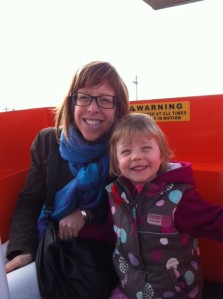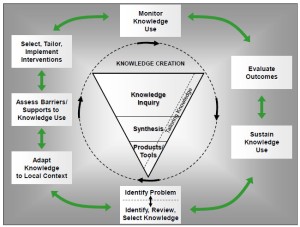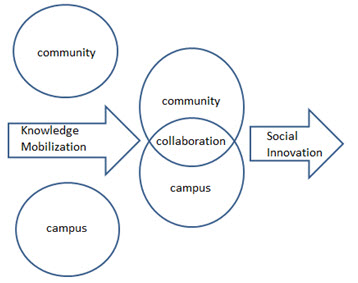David Phipps, RIR-York
Is a picture worth a thousand words? David Phipps tries to explain knowledge mobilization and social innovation more succinctly than that.
Une image vaut-elle mille mots? David Phipps tente d’expliquer la mobilisation des connaissances et l’innovation sociale de façon plus succincte que cela.
On March 13, 2013, I published that knowledge mobilization helps make research useful to society. I tried to make it simple so anyone can understand why we do what we do. And now for another over simplification but one that hopefully explains how we do what we do.
In 2009, we published that knowledge mobilization is a process that enables social innovation. Knowledge mobilization (the how) enables social innovation (the what). I recently took
 Naomi Nichols and Fiona
Naomi Nichols and Fiona
this one step further with my colleague and new mom, Naomi Nichols. We have a paper about to come out in the Canadian Journal of Nonprofit and Social Economy Research. SSHRC gave me and Allyson Hewitt (Advisor, Social Innovation and Director, Social Entrepreneurship, MaRS) a small grant to explore methods to leverage investments in higher education and research. Our synthesis (thanks to Johanne Provencal for the heavy lifting) mapped out the theoretical relationships between knowledge mobilization, community campus collaborations and social innovation. We identified literature and practices that took « the how » and « the what » above one step further. Our analysis shows that knowledge mobilization is a process that produces community campus collaborations and some of those community campus collaborations enable social innovation. In a logic model framework:
- activity = knowledge mobilization
- outcome = community campus collaborations
- impact = social innovation
We were asked by the reviewers to provide a diagram of this relationship. This was a daunting task. Many diagrams of knowledge mobilization type activities are necessarily complex reflecting the multi-directional, multi-stakeholder, multi-disciplinary (mutli-everything!) nature of our work. On the left is a model from: Bennet, Alex and David Bennet. 2008. Knowledge mobilization in the social sciences and humanities: moving from research to action. Frost, West Virginia, USA: MQI Press. On the right is the KTA model from: Graham Ian D. et al. 2006. “Lost in knowledge translation: time for a map?” J Contin EducHealth Prof 26(1):13-24.


But remembering the post on March 13, 2013 … keep it simple stupid.
So we came up with the following. A drastically oversimplified diagram illustrating a complex process but it does show that knowledge mobilization is a process that brings communities and campuses into a shared space so they can collaborate and hopefully enable social innovations.

Knowledge mobilization is a process that produces community campus collaborations which can enable social innovation.
In this case a picture is worth only 15 words.